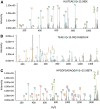Top-Down ETD-MS Provides Unreliable Quantitation of Methionine Oxidation
- PMID: 31662705
- PMCID: PMC6808186
- DOI: 10.7171/jbt.19-3004-002
Top-Down ETD-MS Provides Unreliable Quantitation of Methionine Oxidation
Abstract
Methionine oxidation plays a critical role in many processes of biologic and biomedical importance, including cellular redox responses and stability of protein pharmaceuticals. Bottom-up methods for analysis of methionine oxidation can suffer from incomplete sequence coverage, as well as an inability to readily detect correlated oxidation between 2 or more methionines. However, the methodology for quantifying protein oxidation in top-down analyses is lacking. Previous work has shown that electron transfer dissociation (ETD)-based tandem mass spectrometry (MS/MS) fragmentation offers accurate and precise quantification of amino acid oxidation in peptides, even in complex samples. However, the ability of ETD-based MS/MS fragmentation to accurately quantify amino acid oxidation of proteins in a top-down manner has not been reported. Using apomyoglobin and calmodulin as model proteins, we partially converted methionines into methionine sulfoxide by incubation in H2O2. Using top-down ETD-based fragmentation, we quantified the amount of oxidation of various ETD product ions and compared the quantified values with those from traditional bottom-up analysis. We find that overall quantification of methionine oxidation by top-down MS/MS ranges from good agreement with traditional bottom-up methods to vast differences between the 2 techniques, including missing oxidized product ions and large differences in measured oxidation quantities. Care must be taken in transitioning ETD-based quantitation of oxidation from the peptide level to the intact protein level.
Keywords: hydroxyl radical protein footprinting; post-translational modification; proteomics.
© Association of Biomolecular Resource Facilities.
Figures








Similar articles
-
Rapid Quantification of Peptide Oxidation Isomers From Complex Mixtures.Anal Chem. 2020 Mar 3;92(5):3834-3843. doi: 10.1021/acs.analchem.9b05268. Epub 2020 Feb 17. Anal Chem. 2020. PMID: 32039584 Free PMC article.
-
Supercharging by m-NBA Improves ETD-Based Quantification of Hydroxyl Radical Protein Footprinting.J Am Soc Mass Spectrom. 2015 Aug;26(8):1424-7. doi: 10.1007/s13361-015-1129-7. Epub 2015 Apr 28. J Am Soc Mass Spectrom. 2015. PMID: 25916598 Free PMC article.
-
Improved identification and relative quantification of sites of peptide and protein oxidation for hydroxyl radical footprinting.J Am Soc Mass Spectrom. 2013 Nov;24(11):1767-76. doi: 10.1007/s13361-013-0719-5. Epub 2013 Sep 7. J Am Soc Mass Spectrom. 2013. PMID: 24014150 Free PMC article.
-
Electron capture dissociation mass spectrometry in characterization of peptides and proteins.Biotechnol Lett. 2006 Jul;28(14):1047-59. doi: 10.1007/s10529-006-9065-z. Epub 2006 Jun 23. Biotechnol Lett. 2006. PMID: 16794768 Review.
-
Application of electron transfer dissociation (ETD) for the analysis of posttranslational modifications.Proteomics. 2008 Nov;8(21):4466-83. doi: 10.1002/pmic.200800329. Proteomics. 2008. PMID: 18972526 Review.
Cited by
-
Profiling Dopamine-Induced Oxidized Proteoforms of β-synuclein by Top-Down Mass Spectrometry.Antioxidants (Basel). 2021 Jun 1;10(6):893. doi: 10.3390/antiox10060893. Antioxidants (Basel). 2021. PMID: 34206096 Free PMC article.
-
Top-Down Detection of Oxidative Protein Footprinting by Collision-Induced Dissociation, Electron-Transfer Dissociation, and Electron-Capture Dissociation.Anal Chem. 2022 Jul 19;94(28):9993-10002. doi: 10.1021/acs.analchem.1c05476. Epub 2022 Jul 7. Anal Chem. 2022. PMID: 35797180 Free PMC article.
References
-
- Berlett BS, Stadtman ER. Protein oxidation in aging, disease, and oxidative stress. J Biol Chem. 1997;272:20313–20316 - PubMed
Publication types
MeSH terms
Substances
LinkOut - more resources
Full Text Sources
